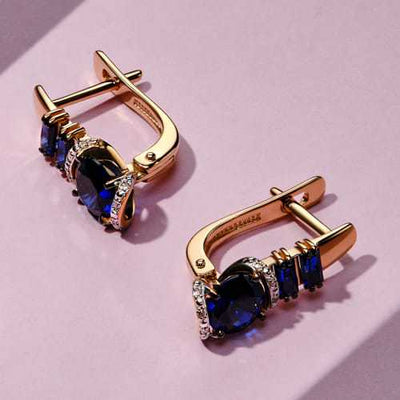The fourth article in our four-part series about the 4 C’s of diamonds is focused on the term “clarity.” When you hear people talk about diamond clarity, they are talking about any imperfections that the diamond may have on the surface or inside of the stone. There are two different types of natural flaws that can occur. The first types of imperfections are surface flaws called blemishes, and the second type are internal flaws called inclusions. During diamond grading, experts will look at the clarity of a diamond to see if they find both of these types of flaws.
Read the previous article in our series: diamond color
What Are Inclusions and Blemishes?
We’ve covered the basic definition of each of these terms, but what qualifies as an inclusion or blemish?
Internal imperfections, called inclusions, include clouds, feathers, crystals, minerals, knots, cavities, cleavage, and internal graining. External imperfections are called blemishes. Common blemishes include polish lines, scratches, nicks, pits, chips, breaks, and light or dark spots.
Common Types of Inclusions Explained
Some of the most common types of inclusions are:
- Bearding: Bearding occurs near the girdle and can cause a slightly blurry or fuzzy appearance on the diamond.
- Cavity: Cavities are inclusions that can either appear colorless or not depending on the minerals that exist in the body of the diamond. If the cavities are colored, they are more obvious to the naked eye.
- Feather: Feathers are small cracks that occur in the diamond. Depending on the angle you are viewing the diamond, you may see these cracks as transparent. However, feathers can also capture light and create a white appearance.
- Graining: Graining occurs due to irregular crystal growth. These crystals can cause internal graining that can appear white, colored, or reflective, which can cause a hazy appearance in the stone.
How Does Clarity Grading Work?

The grading values that can be assigned to a diamond’s clarity are as follows:
- FL-Flawless: A diamond is considered flawless when it has no inclusions or blemishes visible to a skilled grader at 10x magnification.
- IF-Internally Flawless: An Internally Flawless diamond is one that has no inclusions and only blemishes that are visible to a skilled graded at 10x magnification.
- VVS1/VVS2-Very, Very Slightly Included: Diamonds receive a VVS1 grade when they have minute inclusion that ranges from extremely difficult to very difficult to see for a skilled grader at 10x magnification.
- VS1/VS2-Very Slightly Included: Diamonds with minor inclusions that range from difficult to somewhat easy to see for a skilled grader at 10x magnification.
- S1/S2-Slightly Included: Diamonds with noticeable inclusions ranging from easy to very easy to see for a skilled grader at 10x magnification are given either the S1 or S2 grade.
- I1/I2/I3-Included: Included diamonds are those with obvious inclusions that are visible to a skilled grader at 10x magnification. At this point, the inclusions might affect the transparency and brilliance of the diamond.
Five Factors That Go into Clarity Gradings
- Size: The size of the inclusions or blemishes is the first thing to be considered when determining a diamond’s clarity grading.
- Number: The number of easily seen imperfections (not the total number of flaws) is the next greatest consideration when it comes to clarity gradings.
- Position: The position of imperfections is also important to the grading of the diamond. If an inclusion is under the table and close to the pavilion of the stone, it is going to be very noticeable and will have a larger impact on the grading of the diamond.
- Nature: The nature of the imperfection is the fourth factor for grading a diamond’s clarity. This term refers to whether the imperfection is inside the diamond or on its surface. Internal flaws create a situation in which a diamond can’t be graded as flawless or internally flawless.
- Color and relief: Color and relief is a measure of how easily seen a characteristic is. This could also be defined as how much contrast there is between the characteristic and the surrounding part of the diamond.
How Do the Other C’s Affect Clarity?
Diamond shape and size can also affect the stone’s clarity.
A diamond’s shape may require that it have a higher clarity grade than a similar diamond of a different cut. For example, Asscher and emerald cut diamonds are created using the step cut, which emphasizes transparency. This means that inclusions will be more visible with one of these cuts. If you want a diamond with an Asscher or emerald cut, you will want to make sure that you choose one with a clarity of VS1 or better so that the inclusions aren’t visible. However, cuts with more brilliance, like round or princess, do a much better job of hiding inclusions.
The larger a diamond is, the larger the size of the facets, which can make inclusions more visible. If you are getting a larger carat weight, you might want to also consider a higher clarity grade to ensure that the diamond still looks beautiful.
If you are interested in purchasing a diamond with the help of local experts, Noe’s Jewelry in Raymore, Missouri is the perfect place to start. To learn more, drop in or give us a call today at 816-322-7227.
Part one of the 4 C’s series: carat weight
Part two of the 4 C’s series: diamond cut
Part three of the 4 C’s series: diamond color
Part four of the 4 C’s series: clarity





